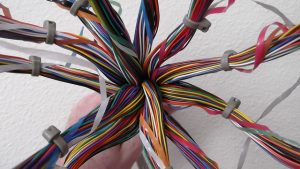It’s 3:15 am and I couldn’t sleep because I was thinking about and reflecting on how we learn and what we want to get out of our learning. I am thinking about my Romanticism class that is taking part in the Connecting Classes project. What do we want… Perhaps that is the greatest starting point – to want to get something out of it. In my teaching, in my life, I admit to starting from my own perspective (I suppose in psychology terms each person’s perspective is the ultimate starting point) and then I work out to see how I can understand an experience and best shape it for my fellow learners. What can I use to supplement or enhance? How can it be relevant to that person’s driving passions in music? How can we engage in learning together? How can we amplify each other’s experience?
I remember being a student and turning up to my lecture, sitting in a great hall with some hundred other students as an older man walked slowly across the stage to read from a book. The History of Western Music by Donald J. Grout. It was a text book and every week we were supposed to read some 30-50 pages and then it would be dissected. Honestly, it was a missed opportunity, because the professors were notable people and I don’t think I ever had a single conversation with them. I don’t think I was very interested at all. Attendance was requisite and to pass we did some sort of short answer, paper based test, that included drop the needle listening examples where we wrote out qualities of different musics. I don’t remember very much of what happened – I was never good at reading textbooks or sitting still while someone discussed the textbook at you. I certainly didn’t know how it related to me as a cello student. Shame really, because it did. There is relevance in understanding who and what and why. There is relevance in understanding all different sorts of music, especially if I might be playing some of that music, or even music by someone influenced by whoever was the composer of the day. There are always connections.
That is one thing I hope to achieve with Connecting Classes: relevant connections.
How?
Connecting classes is not using a text book. It’s using media as a conduit for these connections. The tech can be baffling. If for no other reason, there is a sheer volume of variety bombarded at people both as consumers and students. Honestly it is hard to know what is good, what’s out there, and what it’s for. Often the perceived answers to those are planted by the companies who market their ‘thing’. Then there are the inherent limitations of access – you might need a certain kind of something to use that thing. Someone in my class said they only carry a basic phone and use their laptop for all the ‘smart’ things – so tweeting will have to wait until later. Fair enough! -but that is a limitation to how and when certain tech platforms or applications are used.
Then there is the ‘how’ as defined by the common user.
Here’s an example:
If I am given a box and I use it as a box, that is great. Useful. Just like it says. But what about the children who use the box to make a fort? Useful? That particular use is not first on the list of the postal worker, but for the child, oh yes it is useful! I want to think of the box in many different ways: as a container, a shelter, a toy, as material to build models, as reinforcement (the strength in the corrugation). It could be a blank canvas on which or from which to build.
I want to think inside, outside, around, and through the box.
That way instead of being my container, it becomes my tool.
(image CC BY-NC by id-iom)
This is just it with Connecting Classes. Laura Gogia had a great tweet a while back about using technology, and specifically about the smartphone. To paraphrase, she said – ‘my 6th grader can play with her phone, but it is another thing to write a research paper with it.’ She is so right. It is different to surf, like, and consume (music or products) than it is to use it as a tool. That is what I hope to facilitate through connecting classes, a transformation from using twitter, in this case, as a purely entertaining, social commentary into a tool for information gathering.
Everyone knows about the six degrees of separation.
We all have connections. They must also exist on other levels – about different subject matter. Perhaps the connections are one more step removed (the mathe maticians out there can correct me, I’m sure!) but I am sure they are there to be found. We just have to ask. It brings me back to my professor – the one I never spoke to. He has now passed away, and I missed that opportunity to soak up his stories. I couldn’t see the point as a first year undergraduate. It comes back to the perception and possibility of relevant connections. (Image CC BY SA by Brewbooks)
maticians out there can correct me, I’m sure!) but I am sure they are there to be found. We just have to ask. It brings me back to my professor – the one I never spoke to. He has now passed away, and I missed that opportunity to soak up his stories. I couldn’t see the point as a first year undergraduate. It comes back to the perception and possibility of relevant connections. (Image CC BY SA by Brewbooks)
I don’t suggest that my students will change their habits and all become academics, hot in the pursuit of new knowledge at the turn of every tweet, but I do propose to teach them how to make connections and ask. If out of 20 tweets, they get one reply that leads them to something valuable then they have won. That reply might be a like from someone who is an expert on that subject – and then they need to follow it up. Who liked it? Ah, they have a website where they gather the songs of Romantic composers- how useful, and that leads you to discover a resource or reference…. That kind of seeking and connection takes time to know how to do. That is when the cardboard box becomes useful instead of something to put out with the recycling.
I’m going to build that composer wheel. We made a start, and in the coming weeks I now have the task of building the next couple of sessions’ content. What will they be about? Well, we will keep the composer connections alive and look at the music from different angles. One will be on how current performers approach music from the Romantic period and the last #CClasses session will be on how the composers viewed their work, and we’ll start that one with the point of view of a modern composer – thinking about how he feels when his work is performed and interpreted by others.
Like I said, it is about finding relevant connections.
You may be one of them
#MUL316 #CClasses
(featured image CC BY-NC-ND by Kenneth Martin)

Pingback: Creation, Spark, Learning, & Curriculum - lauraritchie.com
Laura,
I, too, find myself awake, often, at 3:15 a.m. (as you know.) I so appreciate meeting you (via Twitter) and connecting with your transparent and heartfelt effort to continue your learning as part of your teaching. At 65 I feel I am just figuring out how to learn and so can appreciate how you begin this post.
We have on our site, http://youngwritersproject.org an idea that we stole from Jonathan Harris (a brilliant artist, coder and writer who invented http://cowbird.com and snagged me early on to populate the site with sound/photo/word stories) — The Sprout. The idea is that when you read something/see something that someone else has created on the Web you can react, tend to react, in these ways:
Move on and say nothing.
Love or like it (or now, in the Facebook Generation, emoticon it)
Comment on it — say WHY you liked it.
Provide feedback — articulate what your brain noticed in a way that is well-received that gives the creator valuable knowledge from her/his audience.
Sprout It, meaning, “I read your piece and it so moved me, it got me thinking so deeply, that I recalled this or it made me think about that and I want to share it with you.” This, to me, is the highest honor you can give a digital piece.
So, along those lines, and along the lines of your work to have students — with Jonathan Worth, connect with each other on Twitter around the theme of impressions, learning, observations, sprouts, related to the Romantic Composers, this piece leapt, through no fault of your own, into my brain:
https://youtu.be/qxnpUbXHPSI
What this is, I think, is one of the most lyrical, beautiful, intriguing performances that brings the dead to life, combing it with today’s musical sensibilities, a texture deep and complex with musical history. This is a group of Polish musicians performing, live, by circling around, weaving in and out of, an archival recording from long ago of women singing a traditional Polish song. It is to me what Classical musicians do every day, in a much more subtle way, as they re-interpret the notes and directions and intentions and habits of composers from one/two centuries ago.
The personal connection is that my oldest daughter Anna has and is collaborating with these musicians in her work to combine the old and the new. So she is responsible for turning me onto these musicians and their work; she and I share awe at what they are doing. And now I pass them along to you in hopes that someday what they and many other musicians in the traditional music field all over the world are experimenting with — gain more audience with their techniques for connecting the creativity of past and present. So maybe another musician could sprout it.
enjoy
g
The comment below was shared by Laura Gibbs on G+ in the group Open Teaching (https://plus.google.com/collection/wSQvGB) The link she includes at the end is BRILLIANT as a writing prompt:
YES yes yes, how to make CONNECTIONS and ASK
In a recent post students did about #growthmindset (a.k.a. self-efficacy!), I had listed “asking lots of questions” as one of the many indicators of a growth mindset, and when students were commenting on which traits they identified with, so many remarked that school had basically taught them not to ask questions because it’s easier just not to ask questions. I was also struck by students who said they would ask questions of their peers but never their professors!
Here’s the post prompt:
http://onlinecourselady.pbworks.com/w/page/93202908/week8growth
It led to lots of good reflection.